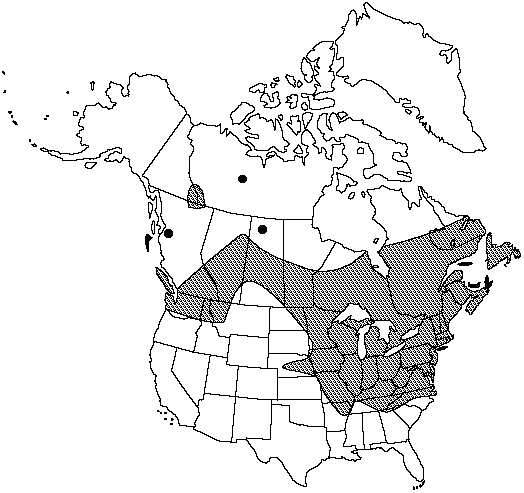Dryopteris carthusiana
Bull. Soc. Bot. France 105: 339. 1959.
Leaves monomorphic, dying in winter, 15–75 × 10–30 cm. Petiole 1/4–1/3 length of leaf, scaly at least at base; scales scattered, tan. Blade light green, ovatelanceolate, 2–3-pinnate-pinnatifid, herbaceous, not glandular. Pinnae ± in plane of blade, lance-oblong; basal pinnae lanceolate-deltate, slightly reduced, basal pinnules usually longer than adjacent pinnules, basal basiscopic pinnule longer than basal acroscopic pinnule; pinnule margins serrate, teeth spiny. Sori midway between midvein and margin of segments. Indusia lacking glands. 2n = 164.
Habitat: Swampy woods, moist wooded slopes, stream banks, and conifer plantations
Elevation: 0–1200 m
Distribution

Alta., B.C., Man., N.B., Nfld. and Labr. (Nfld.), N.W.T., N.S., Ont., P.E.I., Que., Sask., Yukon, Ark., Conn., Del., Idaho, Ill., Ind., Iowa, Ky., Maine, Md., Mass., Mich., Minn., Mo., Mont., Nebr., N.H., N.J., N.Y., N.C., N.Dak., Ohio, Pa., R.I., S.C., Tenn., Vt., Va., Wash., W.Va., Wis., Eurasia
Discussion
Dryopteris carthusiana is tetraploid. Dryopteris intermedia is one parent, as indicated by chromosome pairing in their hybrid D. × triploidea Wherry. The other parent is the hypothetical missing ancestral species " D. semicristata " (see discussion for D. cristata). Dryopteris carthusiana hybridizes with five species; hybrids can be separated from D. intermedia by the lack of glandular hairs and by having 2-pinnate leaves.
Selected References
None.
Lower Taxa
"not" is not a number. "swollen" is not a number."/4lengthofleaf" is not declared as a valid unit of measurement for this property.